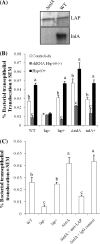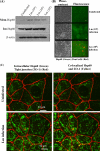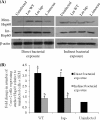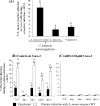Listeria monocytogenes uses Listeria adhesion protein (LAP) to promote bacterial transepithelial translocation and induces expression of LAP receptor Hsp60
- PMID: 20876294
- PMCID: PMC2981324
- DOI: 10.1128/IAI.00516-10
Listeria monocytogenes uses Listeria adhesion protein (LAP) to promote bacterial transepithelial translocation and induces expression of LAP receptor Hsp60
Abstract
Listeria monocytogenes interaction with the intestinal epithelium is a key step in the infection process. We demonstrated that Listeria adhesion protein (LAP) promotes adhesion to intestinal epithelial cells and facilitates extraintestinal dissemination in vivo. The LAP receptor is a stress response protein, Hsp60, but the precise role for the LAP-Hsp60 interaction during Listeria infection is unknown. Here we investigated the influence of physiological stressors and Listeria infection on host Hsp60 expression and LAP-mediated bacterial adhesion, invasion, and transepithelial translocation in an enterocyte-like Caco-2 cell model. Stressors such as heat (41°C), tumor necrosis factor alpha (TNF-α) (100 U), and L. monocytogenes infection (10(4) to 10(6) CFU/ml) significantly (P < 0.05) increased plasma membrane and intracellular Hsp60 levels in Caco-2 cells and consequently enhanced LAP-mediated L. monocytogenes adhesion but not invasion of Caco-2 cells. In transepithelial translocation experiments, the wild type (WT) exhibited 2.7-fold more translocation through Caco-2 monolayers than a lap mutant, suggesting that LAP is involved in transepithelial translocation, potentially via a paracellular route. Short hairpin RNA (shRNA) suppression of Hsp60 in Caco-2 cells reduced WT adhesion and translocation 4.5- and 3-fold, respectively, while adhesion remained unchanged for the lap mutant. Conversely, overexpression of Hsp60 in Caco-2 cells enhanced WT adhesion and transepithelial translocation, but not those of the lap mutant. Furthermore, initial infection with a low dosage (10(6) CFU/ml) of L. monocytogenes increased plasma membrane and intracellular expression of Hsp60 significantly, which rendered Caco-2 cells more susceptible to subsequent LAP-mediated adhesion and translocation. These data provide insight into the role of LAP as a virulence factor during intestinal epithelial infection and pose new questions regarding the dynamics between the host stress response and pathogen infection.
Figures










Similar articles
-
LAP, an alcohol acetaldehyde dehydrogenase enzyme in Listeria, promotes bacterial adhesion to enterocyte-like Caco-2 cells only in pathogenic species.Microbiology (Reading). 2010 Sep;156(Pt 9):2782-2795. doi: 10.1099/mic.0.036509-0. Epub 2010 May 27. Microbiology (Reading). 2010. PMID: 20507888
-
Heat shock protein 60 acts as a receptor for the Listeria adhesion protein in Caco-2 cells.Infect Immun. 2004 Feb;72(2):931-6. doi: 10.1128/IAI.72.2.931-936.2004. Infect Immun. 2004. PMID: 14742538 Free PMC article.
-
Listeria Adhesion Protein Induces Intestinal Epithelial Barrier Dysfunction for Bacterial Translocation.Cell Host Microbe. 2018 Apr 11;23(4):470-484.e7. doi: 10.1016/j.chom.2018.03.004. Epub 2018 Apr 5. Cell Host Microbe. 2018. PMID: 29606495 Free PMC article.
-
Crossing the Intestinal Barrier via Listeria Adhesion Protein and Internalin A.Trends Microbiol. 2019 May;27(5):408-425. doi: 10.1016/j.tim.2018.12.007. Epub 2019 Jan 17. Trends Microbiol. 2019. PMID: 30661918 Review.
-
Listeria monocytogenes: cell biology of invasion and intracellular growth.Microbiol Spectr. 2018 Nov;6(6):10.1128/microbiolspec.gpp3-0013-2018. doi: 10.1128/microbiolspec.GPP3-0013-2018. Microbiol Spectr. 2018. PMID: 30523778 Free PMC article. Review.
Cited by
-
Listeria monocytogenes-How This Pathogen Uses Its Virulence Mechanisms to Infect the Hosts.Pathogens. 2022 Dec 7;11(12):1491. doi: 10.3390/pathogens11121491. Pathogens. 2022. PMID: 36558825 Free PMC article. Review.
-
Pangenome analysis and virulence profiling of Streptococcus intermedius.BMC Genomics. 2021 Jul 9;22(1):522. doi: 10.1186/s12864-021-07829-2. BMC Genomics. 2021. PMID: 34238216 Free PMC article.
-
Listeria monocytogenes and Listeriosis: The Global Enigma.Foods. 2025 Apr 3;14(7):1266. doi: 10.3390/foods14071266. Foods. 2025. PMID: 40238523 Free PMC article. Review.
-
LAP-Hsp60 complex modulates epithelial tight junction barrier.Res Sq [Preprint]. 2025 May 14:rs.3.rs-6474377. doi: 10.21203/rs.3.rs-6474377/v1. Res Sq. 2025. PMID: 40470176 Free PMC article. Preprint.
-
Food-Associated Stress Primes Foodborne Pathogens for the Gastrointestinal Phase of Infection.Front Microbiol. 2018 Aug 23;9:1962. doi: 10.3389/fmicb.2018.01962. eCollection 2018. Front Microbiol. 2018. PMID: 30190712 Free PMC article. Review.
References
-
- Alvarez-Dominguez, C., J. A. Vazquez-Boland, E. Carrasco-Marin, P. Lopez-Mato, and F. Leyva-Cobian. 1997. Host cell heparan sulfate proteoglycans mediate attachment and entry of Listeria monocytogenes, and the listerial surface protein ActA is involved in heparan sulfate receptor recognition. Infect. Immun. 65:78-88. - PMC - PubMed
-
- Bocharov, A. V., T. G. Vishnyakova, I. N. Baranova, A. T. Remaley, A. P. Patterson, and T. L. Eggerman. 2000. Heat shock protein 60 is a high-affinity high-density lipoprotein binding protein. Biochem. Biophys. Res. Commun. 277:228-235. - PubMed
Publication types
MeSH terms
Substances
LinkOut - more resources
Full Text Sources
Other Literature Sources
Medical
Research Materials
Miscellaneous

